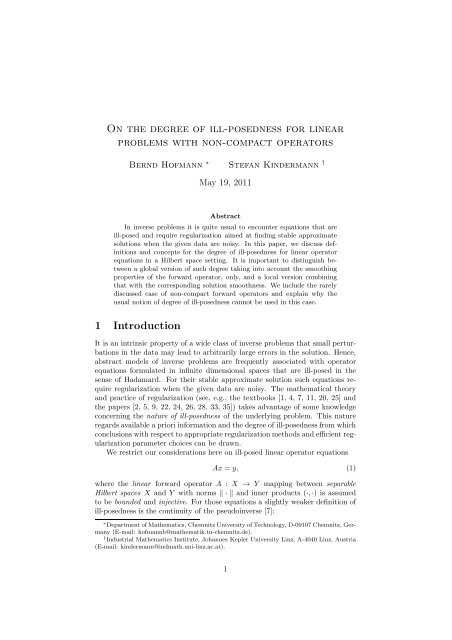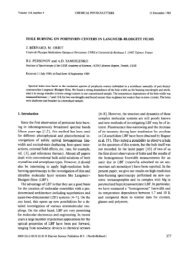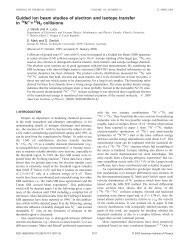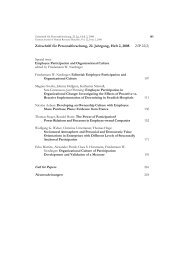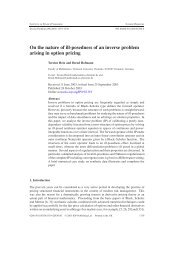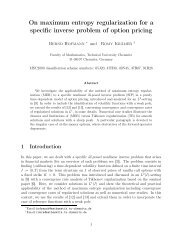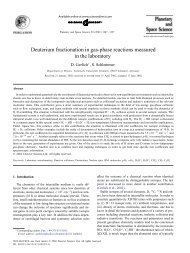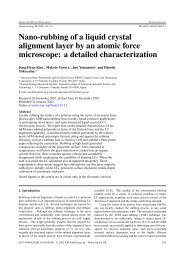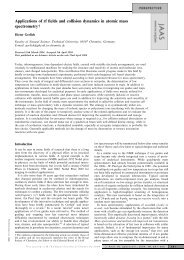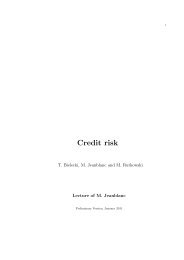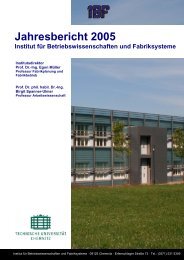On the degree of ill-posedness for linear problems with non-compact ...
On the degree of ill-posedness for linear problems with non-compact ...
On the degree of ill-posedness for linear problems with non-compact ...
You also want an ePaper? Increase the reach of your titles
YUMPU automatically turns print PDFs into web optimized ePapers that Google loves.
<strong>On</strong> <strong>the</strong> <strong>degree</strong> <strong>of</strong> <strong>ill</strong>-<strong>posedness</strong> <strong>for</strong> <strong>linear</strong><br />
<strong>problems</strong> <strong>with</strong> <strong>non</strong>-<strong>compact</strong> operators<br />
Bernd H<strong>of</strong>mann ∗ Stefan Kindermann †<br />
May 19, 2011<br />
Abstract<br />
In inverse <strong>problems</strong> it is quite usual to encounter equations that are<br />
<strong>ill</strong>-posed and require regularization aimed at finding stable approximate<br />
solutions when <strong>the</strong> given data are noisy. In this paper, we discuss definitions<br />
and concepts <strong>for</strong> <strong>the</strong> <strong>degree</strong> <strong>of</strong> <strong>ill</strong>-<strong>posedness</strong> <strong>for</strong> <strong>linear</strong> operator<br />
equations in a Hilbert space setting. It is important to distinguish between<br />
a global version <strong>of</strong> such <strong>degree</strong> taking into account <strong>the</strong> smoothing<br />
properties <strong>of</strong> <strong>the</strong> <strong>for</strong>ward operator, only, and a local version combining<br />
that <strong>with</strong> <strong>the</strong> corresponding solution smoothness. We include <strong>the</strong> rarely<br />
discussed case <strong>of</strong> <strong>non</strong>-<strong>compact</strong> <strong>for</strong>ward operators and explain why <strong>the</strong><br />
usual notion <strong>of</strong> <strong>degree</strong> <strong>of</strong> <strong>ill</strong>-<strong>posedness</strong> cannot be used in this case.<br />
1 Introduction<br />
It is an intrinsic property <strong>of</strong> a wide class <strong>of</strong> inverse <strong>problems</strong> that small perturbations<br />
in <strong>the</strong> data may lead to arbitrarily large errors in <strong>the</strong> solution. Hence,<br />
abstract models <strong>of</strong> inverse <strong>problems</strong> are frequently associated <strong>with</strong> operator<br />
equations <strong>for</strong>mulated in infinite dimensional spaces that are <strong>ill</strong>-posed in <strong>the</strong><br />
sense <strong>of</strong> Hadamard. For <strong>the</strong>ir stable approximate solution such equations require<br />
regularization when <strong>the</strong> given data are noisy. The ma<strong>the</strong>matical <strong>the</strong>ory<br />
and practice <strong>of</strong> regularization (see, e.g., <strong>the</strong> textbooks [1, 4, 7, 11, 20, 25] and<br />
<strong>the</strong> papers [2, 5, 9, 22, 24, 26, 28, 33, 35]) takes advantage <strong>of</strong> some knowledge<br />
concerning <strong>the</strong> nature <strong>of</strong> <strong>ill</strong>-<strong>posedness</strong> <strong>of</strong> <strong>the</strong> underlying problem. This nature<br />
regardsavailable a priori in<strong>for</strong>mation and <strong>the</strong> <strong>degree</strong> <strong>of</strong> <strong>ill</strong>-<strong>posedness</strong> from which<br />
conclusions<strong>with</strong> respect toappropriateregularizationmethods and efficient regularization<br />
parameter choices can be drawn.<br />
We restrict our considerations here on <strong>ill</strong>-posed <strong>linear</strong> operator equations<br />
Ax = y, (1)<br />
where <strong>the</strong> <strong>linear</strong> <strong>for</strong>ward operator A : X → Y mapping between separable<br />
Hilbert spaces X and Y <strong>with</strong> norms � · � and inner products (·,·) is assumed<br />
to be bounded and injective. For those equations a slightly weaker definition <strong>of</strong><br />
<strong>ill</strong>-<strong>posedness</strong> is <strong>the</strong> continuity <strong>of</strong> <strong>the</strong> pseudoinverse [7]:<br />
∗ Department <strong>of</strong>Ma<strong>the</strong>matics, Chemnitz University <strong>of</strong>Technology, D-09107 Chemnitz, Germany<br />
(E-mail: h<strong>of</strong>mannb@ma<strong>the</strong>matik.tu-chemnitz.de).<br />
† Industrial Ma<strong>the</strong>matics Institute, Johannes Kepler University Linz, A-4040 Linz, Austria<br />
(E-mail: kindermann@indmath.uni-linz.ac.at).<br />
1
Definition 1. The <strong>linear</strong> operator equation (1) is <strong>ill</strong>-posed if and only if <strong>the</strong><br />
pseudoinverse A † is unbounded.<br />
An immediate consequence <strong>of</strong>this definition is <strong>the</strong> following characterization<br />
<strong>of</strong> <strong>ill</strong>-<strong>posedness</strong> (see, e.g., [7]):<br />
Proposition 1. The <strong>linear</strong> operator equation (1) is <strong>ill</strong>-posed if and only if<br />
R(A) �= R(A).<br />
Here R(A) denotes <strong>the</strong> closure <strong>of</strong> <strong>the</strong> range <strong>of</strong> A. Note that <strong>ill</strong>-<strong>posedness</strong><br />
can only occur if <strong>the</strong> range R(A) is an infinite dimensional subspace <strong>of</strong> Y. A<br />
ca<strong>non</strong>ical example <strong>of</strong> an <strong>ill</strong>-posed operator is a <strong>compact</strong> operator A. However,<br />
not all <strong>ill</strong>-posed <strong>problems</strong> are related to <strong>compact</strong> operators, which led Nashed<br />
in [30] to <strong>the</strong> distinction between <strong>ill</strong>-<strong>posedness</strong> <strong>of</strong> type I and type II:<br />
Definition 2. Let <strong>the</strong> equation (1) be <strong>ill</strong>-posed, i.e. R(A) �= R(A). Then we<br />
call it <strong>ill</strong>-posed <strong>of</strong> type I if A is not <strong>compact</strong> and <strong>of</strong> type II if A is <strong>compact</strong>.<br />
Notethatin<strong>the</strong>case<strong>of</strong><strong>ill</strong>-<strong>posedness</strong><strong>of</strong>typeI<strong>the</strong>rangeR(A)alwayscontains<br />
a closed infinite dimensional subspace and hence a closed infinite dimensional<br />
unit sphere, whereas this is impossible <strong>for</strong> <strong>compact</strong> A. Ano<strong>the</strong>r well-known difference<br />
between <strong>ill</strong>-<strong>posedness</strong><strong>of</strong>type I and II, <strong>for</strong>example mentioned in [14], can<br />
be characterizedby <strong>the</strong> approximation<strong>of</strong>Aby operators<strong>with</strong> finite-dimensional<br />
range:<br />
Proposition 2. Let (1) be <strong>ill</strong>-posed. Then <strong>the</strong> equation is <strong>ill</strong>-posed <strong>of</strong> type II<br />
if and only if <strong>the</strong>re exists a sequence {AN : X → Y}N∈N <strong>of</strong> bounded <strong>linear</strong><br />
operators <strong>with</strong> finite dimensional range, dim(R(AN)) = N, such that<br />
lim<br />
N→∞ �A−AN� → 0.<br />
The distinction between type I and type II <strong>ill</strong>-posed problem does not tell<br />
very much how difficult it is to solve an actual <strong>ill</strong>-posed problem. There<strong>for</strong>e,<br />
sincethirty years<strong>the</strong> inverse<strong>problems</strong>communityhasrealizedthat <strong>the</strong> <strong>degree</strong> <strong>of</strong><br />
<strong>ill</strong>-<strong>posedness</strong> distinguishing mildly, moderately and severely <strong>ill</strong>-posed <strong>problems</strong><br />
plays a prominent role in <strong>the</strong>ory and practice <strong>of</strong> regularization. Such <strong>degree</strong><br />
should reflect <strong>the</strong> level <strong>of</strong> challenge which is posed in <strong>the</strong> context <strong>of</strong> reconstructing<br />
solutions to (1). In <strong>the</strong> literature we can find two different approaches <strong>for</strong><br />
measuring <strong>the</strong> <strong>degree</strong> <strong>of</strong> <strong>ill</strong>-<strong>posedness</strong> in a Hilbert space setting.<br />
Thefirstapproachtakesintoaccount<strong>the</strong>smoothingproperties<strong>of</strong><strong>the</strong><strong>for</strong>ward<br />
operatorA, only, and exploits <strong>the</strong> fact that those properties are globally uni<strong>for</strong>m<br />
on <strong>the</strong> whole Hilbert space because A is <strong>linear</strong>. A quantitative measure <strong>of</strong> <strong>the</strong><br />
<strong>degree</strong> <strong>of</strong> <strong>ill</strong>-<strong>posedness</strong> <strong>for</strong> that global approach is yielded by <strong>the</strong> decay rate<br />
σn = σn(A) → 0 as n → ∞ <strong>of</strong> <strong>the</strong> singular values �A� = σ1 ≥ σ2 ≥ ...<br />
<strong>of</strong> A arranged in decreasing order, but only when A is <strong>compact</strong> and hence<br />
possesses a purely discrete spectrum (type II <strong>ill</strong>-<strong>posedness</strong>). In [17, §1] and [27,<br />
§2] one can find a collection <strong>of</strong> basic and textbook references <strong>for</strong> that approach<br />
in <strong>the</strong> <strong>compact</strong> case. However, as was outlined in [14] <strong>with</strong> focus on <strong>ill</strong>-posed<br />
multiplication operators <strong>with</strong> purely continuous spectrum it is difficult to find<br />
surrogate tools <strong>for</strong> measuring <strong>the</strong> <strong>degree</strong> <strong>of</strong> <strong>ill</strong>-<strong>posedness</strong> in <strong>the</strong> <strong>non</strong>-<strong>compact</strong><br />
case (type I <strong>ill</strong>-<strong>posedness</strong>). <strong>On</strong>e goal <strong>of</strong> this paper is to obtain some progress in<br />
that field.<br />
2
Thesecondandalternativeapproach<strong>for</strong>measuring<strong>the</strong><strong>degree</strong><strong>of</strong><strong>ill</strong>-<strong>posedness</strong>,<br />
early introduced in <strong>the</strong> German textbook [25], is a more local one <strong>with</strong> focus on<br />
some specific solution x † to equation (1) basedon <strong>the</strong> interplay<strong>of</strong><strong>the</strong> smoothing<br />
properties <strong>of</strong> A and <strong>the</strong> solution smoothness <strong>of</strong> x † . There are good arguments<br />
to prefer that approach: For example, severely <strong>ill</strong>-posed <strong>problems</strong> may occur on<br />
<strong>the</strong> one hand if A is strongly smoothing (exponential decay <strong>of</strong> singular values<br />
<strong>for</strong> <strong>compact</strong> A) and x † is <strong>of</strong> medium smoothness <strong>with</strong> respect to A or on <strong>the</strong><br />
o<strong>the</strong>r hand if A is moderately smoothing (power-type decay <strong>of</strong> singular values<br />
<strong>for</strong> <strong>compact</strong> A) and <strong>the</strong> smoothness<strong>of</strong> x † <strong>with</strong> respect to Ais verylow expressed<br />
by logarithmic source conditions, see e.g. [19]. As Neubauer already stated in<br />
[31], <strong>the</strong> spectral distribution function F 2 x(t) = µx((0,t]) <strong>of</strong> <strong>the</strong> element x ∈ X<br />
<strong>with</strong> respect to <strong>the</strong> positive self-adjoint bounded <strong>linear</strong> operator H := A ∗ A<br />
provides us <strong>with</strong> very precise in<strong>for</strong>mation about <strong>the</strong> smoothness <strong>of</strong> this element<br />
and in contrast to <strong>the</strong> singular values this ma<strong>the</strong>matical tool is also available<br />
<strong>for</strong> <strong>non</strong>-<strong>compact</strong> operators A. Here we have t > 0, µx(B) := (χB(H)x,x) is <strong>the</strong><br />
corresponding measure defined <strong>for</strong> Borel sets B ⊂ (0,∞), and χB(·) denotes <strong>the</strong><br />
characteristic function We are going to use that fact <strong>for</strong> getting a deeper insight<br />
into <strong>the</strong> <strong>non</strong>-<strong>compact</strong> case.<br />
The paper is organized as follows: In Section 2 we discuss different concepts<br />
<strong>for</strong> measuring <strong>ill</strong>-<strong>posedness</strong> based, only, on smoothing properties <strong>of</strong> A in <strong>the</strong><br />
<strong>compact</strong> as well as in <strong>the</strong> <strong>non</strong>-<strong>compact</strong> case. In this context, we prove <strong>the</strong> existence<br />
<strong>of</strong> a clear borderline between those cases by considering finite dimensional<br />
discretizations. Section 3 consists <strong>of</strong> a brief visit to <strong>non</strong>-<strong>compact</strong> examples.<br />
We conclude this paper <strong>with</strong> some new assertions on <strong>the</strong> interplay <strong>of</strong> solution<br />
smoothness and smoothing properties <strong>of</strong> A by exploiting <strong>the</strong> function F 2 x expressing<br />
<strong>the</strong> energy distribution <strong>of</strong> an element x <strong>with</strong> respect to <strong>the</strong> spectrum<br />
<strong>of</strong> H = A ∗ A.<br />
2 Some concepts <strong>for</strong> measures <strong>of</strong> <strong>ill</strong>-<strong>posedness</strong><br />
We start <strong>with</strong> what we think is <strong>the</strong> least requirement <strong>of</strong> a measure <strong>of</strong> <strong>ill</strong><strong>posedness</strong>:<br />
Definition 3. A measure <strong>of</strong> <strong>ill</strong>-<strong>posedness</strong> <strong>for</strong> equation (1) taking into account<br />
<strong>the</strong> smoothing properties <strong>of</strong> A, only, should correspond <strong>with</strong> some partial ordering<br />
A ≤ B <strong>of</strong> <strong>the</strong> <strong>for</strong>ward operators. For a given measure <strong>of</strong> <strong>ill</strong>-<strong>posedness</strong>, we<br />
call ‘A more <strong>ill</strong>-posed than B’ if A ≤ cB <strong>with</strong> some constants c > 0, in <strong>the</strong><br />
same manner ‘B more <strong>ill</strong>-posed than A’ if B ≤ cA, and ‘A as <strong>ill</strong>-posed as B’ if<br />
A ≤ c1B and B ≤ c2A <strong>for</strong> two constants c1,c2 > 0.<br />
However, <strong>the</strong>re is a ca<strong>non</strong>ical partial ordering only <strong>for</strong> <strong>non</strong>-negative selfadjoint<br />
operators S,T : X → X defined as<br />
where <strong>the</strong> implication<br />
S ≤ T ⇐⇒ (Sx,x) ≤ (Tx,x) ∀x ∈ X,<br />
S ≤ T =⇒ ϕ(S) ≤ ϕ(T) (2)<br />
holds <strong>for</strong> operator monotone functions ϕ : (0,∞) → (0,∞). Our <strong>for</strong>ward operators<br />
A are in general not self-adjoint. There<strong>for</strong>e a symmetrization seems to<br />
3
e necessary and we arrive at H := A ∗ A or at powers H κ , κ > 0, to be used<br />
as S and T. A monomial ϕ(t) = t ν , t > 0, is operator monotone if and only<br />
if 0 < ν ≤ 1. If we start <strong>with</strong> κ = 2 motivated below and define <strong>for</strong> <strong>the</strong> <strong>for</strong>ward<br />
operators in (1) a partial ordering by ((A ∗ A) 2 x,x) ≤ ((B ∗ B) 2 x,x) <strong>for</strong> all<br />
x ∈ X, <strong>the</strong>n this implies <strong>with</strong> ν = 1/2 <strong>the</strong> inequality (A ∗ Ax,x) ≤ (B ∗ Bx,x)<br />
<strong>for</strong> all x ∈ X. So we use <strong>the</strong> latter case <strong>for</strong> a first specified definition. Note<br />
that S ≤ cT <strong>for</strong> some arbitrary c > 0 is equivalent to <strong>the</strong> range inclusion<br />
R(S) ⊆ R(T) (cf. [3, Prop. 2.1]).<br />
Definition 4. We define a first measure <strong>of</strong> <strong>ill</strong>-<strong>posedness</strong> on <strong>the</strong> set <strong>of</strong> bounded<br />
<strong>linear</strong> operators A,B : X → Y by <strong>the</strong> partial ordering<br />
A ≤norm B ⇐⇒ �Ax� ≤ �Bx� ∀x ∈ X. (3)<br />
This ordering can be rewritten as A ∗ A ≤ B ∗ B in <strong>the</strong> sense <strong>of</strong> <strong>the</strong> ca<strong>non</strong>ical<br />
ordering <strong>for</strong> <strong>non</strong>-negative self-adjoint operators. Most <strong>of</strong> <strong>the</strong> usual ways <strong>of</strong><br />
ordering operators according to <strong>the</strong>ir <strong>ill</strong>-<strong>posedness</strong> are extensions <strong>of</strong> an operator<br />
ordering by exploiting implication (2) <strong>with</strong> a certain index function ϕ. Here, we<br />
call an ordering ≤2 an extension <strong>of</strong> ano<strong>the</strong>r ordering ≤1 if <strong>the</strong> implication<br />
A ≤1 B =⇒ A ≤2 B<br />
holds. An extension ≤2 is thus a more detailed way to order operators than ≤1.<br />
For<strong>compact</strong>operators<strong>the</strong>inequalityA ≤norm cB in<strong>the</strong>sense<strong>of</strong>Definition4<br />
implies<strong>the</strong> correspondinginequalitiesσn(A) ≤ cσn(B), ∀n ∈ N, <strong>for</strong><strong>the</strong> singular<br />
values (see, e.g., [11, Lemma 2.46]). Consequently, if A is more <strong>ill</strong>-posed than<br />
B <strong>the</strong>n <strong>the</strong> decay rate to zero <strong>of</strong> <strong>the</strong> singular values <strong>of</strong> B is not faster than<br />
<strong>the</strong> associated decay rate <strong>for</strong> A and hence solving an <strong>ill</strong>-posed problem <strong>with</strong> B<br />
is not more difficult than <strong>the</strong> same <strong>for</strong> A, which motivates this definition. As<br />
mentioned we have here that A ≤norm cB is equivalent to <strong>the</strong> range inclusion<br />
R(A ∗ ) = R((A ∗ A) 1/2 ) ⊆ R(B ∗ ) = R((B ∗ B) 1/2 ) and this can never occur when<br />
B is <strong>compact</strong> and A is not <strong>compact</strong> since <strong>the</strong>n R(A ∗ ) has a closed infinite<br />
dimensional subspace which violates <strong>the</strong> <strong>compact</strong>ness <strong>of</strong> B. <strong>On</strong> <strong>the</strong> o<strong>the</strong>r hand,<br />
in particular <strong>for</strong> <strong>non</strong>-<strong>compact</strong> operators A and B, showing that A ≤norm cB<br />
holds in order to compare <strong>the</strong> two operators <strong>with</strong> respect to its <strong>degree</strong> <strong>of</strong> <strong>ill</strong><strong>posedness</strong><br />
is usually quite difficult. An alternative consists <strong>of</strong> characterizing <strong>the</strong><br />
<strong>ill</strong>-<strong>posedness</strong> <strong>of</strong> an operator equation (1) by certain moduli.<br />
Widely used characteristics<strong>of</strong>an <strong>ill</strong>-posedoperatorequationare<strong>the</strong> modulus<br />
<strong>of</strong> injectivity and <strong>the</strong> modulus <strong>of</strong> continuity <strong>of</strong> <strong>the</strong> <strong>for</strong>ward operator.<br />
Definition 5. For a given set M ⊂ X we define <strong>the</strong> modulus <strong>of</strong> injectivity as<br />
j(A,M) := inf<br />
x�=0, x∈M<br />
For δ > 0 <strong>the</strong> modulus <strong>of</strong> continuity is defined as<br />
�Ax�<br />
. (4)<br />
�x�<br />
ω(δ,M,A) := sup{�x� : x ∈ M, �Ax� ≤ δ}. (5)<br />
For conical sets <strong>the</strong>se two moduli are related to each o<strong>the</strong>r:<br />
Proposition 3. Let M be a conical set, i.e., x ∈ M implies λx ∈ M <strong>for</strong> all<br />
λ > 0. Then<br />
δ<br />
j(A,M) = .<br />
ω(δ,M,A)<br />
(6)<br />
4
Pro<strong>of</strong>. For fixed δ > 0 and since M is conical we have<br />
ω(δ,M,A) = sup{�δˆx� : x ∈ M, �Aδˆx� ≤ δ}. = δsup{�ˆx� : x ∈ M, �Aˆx� ≤ 1}<br />
= δ sup<br />
0�=˜x∈M<br />
�˜x�<br />
�A˜x� =<br />
δ<br />
j(A,M) .<br />
For an arbitrary set M <strong>the</strong> modulus <strong>of</strong> continuity ω w<strong>ill</strong>, in general, be infinite<br />
in <strong>the</strong> case <strong>of</strong> <strong>ill</strong>-posed <strong>problems</strong>. In order to get useful in<strong>for</strong>mation out <strong>of</strong><br />
<strong>the</strong>se moduli, one takes families <strong>of</strong> sets M <strong>with</strong> stabilizing properties, preferably<br />
<strong>compact</strong> and hence closed and bounded sets, which make <strong>the</strong> problem (1) restricted<br />
to M conditionally well-posed. Such sets frequently occur in <strong>the</strong> context<br />
<strong>of</strong> conditional stability estimates (cf. [20]), and in <strong>the</strong> method <strong>of</strong> quasisolutions<br />
(cf. [21, 23]). For fur<strong>the</strong>r cross connections to regularization<strong>the</strong>ory we also refer<br />
to [15] and [18, §6.2]. However, <strong>the</strong>re arealsoclosed but unbounded sets M <strong>with</strong><br />
stabilizing properties, namely finite dimensional subspaces <strong>of</strong> X.<br />
We can define measures <strong>of</strong> <strong>ill</strong>-<strong>posedness</strong> using <strong>the</strong> moduli <strong>of</strong> Definition 5 as<br />
follows:<br />
Definition 6. Let {Mγ}γ∈I, be a (not necessarily infinite) family <strong>of</strong> sets in X.<br />
We define<br />
A ≤j,Mγ B ⇐⇒ j(A,Mγ) ≤ j(B,Mγ) ∀γ ∈ I (7)<br />
A ≤ω,Mγ B ⇐⇒ ω(δ,A,Mγ) ≥ ω(δ,B,Mγ) ∀γ ∈ I,δ ∈ (0,δ0) (8)<br />
It follows immediately from <strong>the</strong> definition that <strong>the</strong>se orderings define measure<br />
<strong>of</strong> <strong>ill</strong>-<strong>posedness</strong>:<br />
Lemma 1. The ordering ≤j,Mγ, ≤ω,Mγ define a measure <strong>of</strong> <strong>ill</strong>-<strong>posedness</strong>. If all<br />
Mγ are conical, <strong>the</strong>se two orderings coincide.<br />
2.1 The case <strong>of</strong> type II <strong>ill</strong>-<strong>posedness</strong><br />
The moduli and <strong>the</strong> associated measure <strong>of</strong> <strong>ill</strong>-<strong>posedness</strong>, <strong>of</strong> course, depend<br />
strongly on <strong>the</strong> choice <strong>of</strong> M. For <strong>ill</strong>-posed <strong>problems</strong> <strong>of</strong> type II <strong>the</strong> choice <strong>of</strong> finite<br />
dimensional subspaces is promising. In this context, we consider sequences<br />
{Xn}n∈N <strong>of</strong> nested finite dimensional <strong>with</strong><br />
Xn ⊂ Xn+1, dim(Xn) = n, �<br />
Xn = X, (9)<br />
whichprovideus <strong>with</strong>adiscretization<strong>of</strong><strong>the</strong> operatorequation. In <strong>the</strong>following,<br />
let Pn : X → Xn alwaysdenote<strong>the</strong> orthogonalprojectorontoXn. The sequence<br />
<strong>of</strong> moduli {j(A,Xn)}n∈N and {ω(δ,A,Xn)}n∈N associated to <strong>the</strong> discretization<br />
by <strong>the</strong> nested sequence {Xn}n∈N satisfying (9) allows us to define <strong>the</strong> orderings<br />
≤j,Xn and ≤ω,Xn as in (7), (8). For <strong>the</strong> sets M = Xn <strong>the</strong> identity (6), which is<br />
now a consequence <strong>of</strong> Proposition 3, has been shown already in in [15].<br />
For <strong>compact</strong> operators, estimates <strong>for</strong> j(A,Xn) are obtained by <strong>the</strong> singular<br />
values:<br />
5<br />
n∈N
Proposition 4. Let <strong>the</strong> nested sequence {Xn}n∈N satisfy (9). For A being a<br />
<strong>compact</strong> operator, let {σn,un,vn}n∈N be <strong>the</strong> singular system <strong>of</strong> A. Then we have<br />
j(A,Xn) ≤ σn ∀ n ∈ N.<br />
Moreover we have equality if Xn = span{u1,...,un} is <strong>the</strong> n-dimensional subspace<br />
corresponding to <strong>the</strong> singular functions ui (i = 1,2,...,n) to <strong>the</strong> n largest<br />
singular values σn <strong>of</strong> A.<br />
Hence, <strong>for</strong> type II <strong>problems</strong> in separable Hilbert spaces <strong>the</strong>re is a ca<strong>non</strong>ical<br />
choice <strong>of</strong> subspaces Xn, namely <strong>the</strong> appropriate n-dimensional subspace generated<br />
by <strong>the</strong> singular value decomposition. Note that we have <strong>the</strong> well-known<br />
max-min characterization <strong>of</strong> <strong>the</strong> singular values,<br />
σn(A) = max<br />
Xn<br />
min<br />
z∈Xn\{0}<br />
�Az�<br />
�z�<br />
= maxj(A,Xn),<br />
(10)<br />
Xn<br />
where <strong>the</strong> maximum is taken over all n-dimensional subspaces. This gives a<br />
uni<strong>for</strong>m lower bound on <strong>the</strong> sequence <strong>of</strong> modulus <strong>of</strong> injectivity <strong>for</strong> type II <strong>problems</strong>.<br />
We w<strong>ill</strong> see later, that <strong>the</strong> existence <strong>of</strong> such a uni<strong>for</strong>m bound actually<br />
characterizes type II <strong>problems</strong>.<br />
By this lower bound, <strong>the</strong> definition <strong>of</strong> ≤j,Xn in (7) can be extended to a<br />
ordering that is independent <strong>of</strong> <strong>the</strong> discretization {Xn}n∈N.<br />
Definition 7. For A and B being <strong>compact</strong> operators <strong>the</strong> measure <strong>of</strong> <strong>ill</strong>-<strong>posedness</strong><br />
according to <strong>the</strong> singular values is defined as<br />
A ≤σ B ⇐⇒ σn(A) ≤ σn(B) ∀n ∈ N. (11)<br />
Lemma 2. The ordering ≤σ defines a measure <strong>of</strong> <strong>ill</strong>-<strong>posedness</strong>. Moreover if<br />
A ≤j,Xn B <strong>for</strong> all nested sequences {Xn}n∈N satisfying (9), <strong>the</strong>n A ≤σ B. <strong>On</strong><br />
<strong>the</strong> o<strong>the</strong>r hand if A ≤σ B, <strong>the</strong>n <strong>the</strong>re exists such a sequence <strong>of</strong> spaces {Xn}n∈N<br />
<strong>with</strong> A ≤j,Xn B.<br />
Pro<strong>of</strong>. Since <strong>the</strong> singular values <strong>of</strong> A are <strong>the</strong> eigenvalues <strong>of</strong> A ∗ A, it follows<br />
from Weyl’s estimates (e.g [29]) that this is a measure <strong>of</strong> <strong>ill</strong>-<strong>posedness</strong> in our<br />
sense.<br />
According to <strong>the</strong>se results, <strong>the</strong> orderings <strong>for</strong> <strong>compact</strong> operators are extensions<br />
in <strong>the</strong> following sense<br />
(A ∗ A) 2 ≤ (B ∗ B) 2 ⇒ 1 A ≤norm B ⇒ A ≤j,Xn B ∀Xn ⇒ A ≤σ B.<br />
The measure <strong>of</strong> <strong>ill</strong>-<strong>posedness</strong> ≤σ can be seen as a uni<strong>for</strong>m measure independent<br />
<strong>of</strong> <strong>the</strong> actual discretization. This measure is useful in defining <strong>the</strong> <strong>degree</strong><br />
<strong>of</strong> <strong>ill</strong>-<strong>posedness</strong> <strong>for</strong> <strong>compact</strong> A:<br />
Definition 8. Let A be a <strong>compact</strong> operator. If <strong>the</strong>re exists a constant C > 0<br />
and a real number 0 < s < ∞ such that<br />
C 1<br />
n s ≤ σn ∀n ∈ N, (12)<br />
1 This implication follows from (2) <strong>with</strong> S := (A ∗ A) 2 , T := (B ∗ B) 2 , and ϕ(t) = t 1/2 .<br />
6
we call <strong>the</strong> equation (1) moderately <strong>ill</strong>-posed <strong>of</strong> <strong>degree</strong> at most s. If <strong>for</strong> all ε > 0,<br />
(12) does not hold <strong>with</strong> s replaced by s − ǫ we call (1) moderately <strong>ill</strong>-posed <strong>of</strong><br />
<strong>degree</strong> s. If no such s exists such that (12) holds, we call (1) severely <strong>ill</strong>-posed. 2<br />
Definition 8 is a slight generalization <strong>of</strong> <strong>the</strong> usual one, where <strong>the</strong> <strong>degree</strong> <strong>of</strong><br />
<strong>ill</strong>-<strong>posedness</strong> <strong>of</strong> an operator equation (1) is s if σn ≍ n −s as n → ∞. If <strong>the</strong><br />
sequence {σn(A)}n∈N possesses subsequences <strong>of</strong> power-type decay <strong>with</strong> varying<br />
exponents, <strong>the</strong>n <strong>the</strong> interval <strong>of</strong> <strong>ill</strong>-<strong>posedness</strong><br />
[j,j] = [liminf<br />
n→∞<br />
−ln(σn)<br />
,limsup<br />
ln(n) n→∞<br />
−ln(σn)<br />
].<br />
ln(n)<br />
introduced in [16] can be <strong>of</strong> interest. Of course, if (1) is <strong>ill</strong>-posed <strong>of</strong> <strong>degree</strong> s,<br />
<strong>the</strong>n j = s. Moreover, <strong>for</strong> σn ≍ n −s <strong>the</strong> interval <strong>of</strong> <strong>ill</strong>-<strong>posedness</strong> degenerates to<br />
a single point j = j = s.<br />
Note that singular values are only defined <strong>for</strong> type II <strong>problems</strong>, hence a<br />
straight<strong>for</strong>ward extension to type I <strong>problems</strong> cannot be seen. We w<strong>ill</strong> show<br />
later that such a notion cannot be defined independently <strong>of</strong> <strong>the</strong> discretization if<br />
A fails to be <strong>compact</strong>.<br />
2.2 The case <strong>of</strong> type I <strong>ill</strong>-<strong>posedness</strong><br />
The singular value decomposition is not defined <strong>for</strong> type I <strong>problems</strong>. Hence, <strong>the</strong><br />
ordering ≤σ, and in particular <strong>the</strong> <strong>degree</strong> <strong>of</strong> <strong>ill</strong>-<strong>posedness</strong> in Definition 8 is not<br />
defined. In this section we discuss possible generalizations <strong>of</strong> ≤σ and obstacles<br />
when extending <strong>the</strong> notion <strong>of</strong> <strong>degree</strong> <strong>of</strong> <strong>ill</strong>-<strong>posedness</strong> to <strong>the</strong> <strong>non</strong>-<strong>compact</strong> case.<br />
Let us look again at <strong>the</strong> max-min principle (10). For <strong>non</strong>-<strong>compact</strong> operators<br />
A this definition does not make sense, because even <strong>for</strong> <strong>ill</strong>-posed <strong>problems</strong><br />
σn(A) does not necessarily tend to zero. This is a consequence <strong>of</strong> <strong>the</strong> fact that<br />
type I operators cannot be approximated uni<strong>for</strong>mly by operators <strong>with</strong> finite<br />
dimensional range (cf. Theorem 2 below).<br />
Along <strong>the</strong> lines <strong>of</strong> [14] one could try to extend <strong>the</strong> <strong>degree</strong> <strong>of</strong> <strong>ill</strong>-<strong>posedness</strong><br />
Definition 8 <strong>for</strong> type I <strong>problems</strong> by using <strong>the</strong> sequence {j(A,Xn)}n∈N in place <strong>of</strong><br />
{σn(A)}n∈N. As <strong>the</strong> singular values <strong>for</strong> type II <strong>problems</strong> <strong>the</strong> numbers j(A,Xn)<br />
tend to zero as n → ∞ if <strong>the</strong> problem is <strong>ill</strong>-posed [14]:<br />
Proposition 5. The equation (1) is <strong>ill</strong>-posed if and only if <strong>for</strong> all discretizations<br />
{Xn}n∈N satisfying (9)<br />
lim<br />
n→∞ j(A,Xn) = 0.<br />
However, as <strong>the</strong> following paradoxical example w<strong>ill</strong> show, an extension <strong>of</strong><br />
Definition 8 in that sense is conflicting.<br />
Example 1. Let {wi}i∈N be an orthonormal basis <strong>for</strong> X. Define <strong>the</strong> bounded<br />
<strong>linear</strong> operator A : X → X as<br />
∞�<br />
i=1<br />
ξiwi ↦→<br />
∞�<br />
i=1<br />
diξiwi<br />
2 Some authors distinguish between mildly <strong>ill</strong>-posed operator equations if 0 < s < 1 and<br />
moderately <strong>ill</strong>-posed one if 1 ≤ s < ∞. Typical behavior <strong>of</strong> severe <strong>ill</strong>-<strong>posedness</strong> is exponential<br />
decay <strong>of</strong> <strong>the</strong> singular values <strong>of</strong> A.<br />
7
<strong>with</strong><br />
di =<br />
� 1<br />
i if i = k 2 <strong>for</strong> some k ∈ N,<br />
1 else.<br />
It is easy to see that this induces is an <strong>ill</strong>-posed problem <strong>of</strong> type I (A <strong>non</strong><strong>compact</strong>).<br />
Now observe what happens if we naively look at <strong>the</strong> <strong>degree</strong> <strong>of</strong> <strong>ill</strong><strong>posedness</strong><br />
in analogy to Definition 8. We can compare <strong>the</strong> operator A <strong>with</strong> <strong>the</strong><br />
operator<br />
B : X → X<br />
∞�<br />
i=1<br />
ξiwi ↦→<br />
∞�<br />
i=1<br />
1<br />
i ξiwi.<br />
It follows immediately that B ≤norm A and hence A is less <strong>ill</strong>-posed than B. It<br />
is straight<strong>for</strong>ward to calculate <strong>the</strong> numbers j(A,Xn) <strong>for</strong> a given discretization<br />
using {wi}i∈N:<br />
Xn = span{wi : i = 1,...n}. (13)<br />
Then<br />
{j(A;Xn)}n∈N = {inf<br />
i {di : i ≤ n}}n∈N = {1,1,1, 1 1 1 1 1 1 1<br />
, , , , , ,<br />
4 4 4 4 4 9 9 ,...},<br />
and<br />
j(B,Xn) = 1<br />
n ≤ j(A;Xn) ∀n ∈ N.<br />
According to <strong>the</strong> definition, <strong>with</strong> respect to this measure, B is <strong>ill</strong>-posed <strong>of</strong> <strong>degree</strong><br />
1, hence <strong>the</strong> operator A is <strong>ill</strong>-posed <strong>of</strong> at most 1.<br />
However, if we look more closely on A, we see that <strong>the</strong> problem (1) can be<br />
split into two <strong>problems</strong>. Denote by Q <strong>the</strong> orthogonal projector onto <strong>the</strong> space<br />
i.e.<br />
Q :<br />
˜X = span{wi : i = k 2 },<br />
∞�<br />
i=1<br />
ξiwi ↦→<br />
Then <strong>the</strong> problem (1) can be solved by<br />
and by two equations<br />
∞�<br />
ξk2wk2 k=1<br />
x = x1 +x2 := Qx+(I −Q)x,<br />
AQx1 = Qy (14)<br />
A(I −Q)x2 = (I −Q)y. (15)<br />
Now <strong>the</strong> second equation (15) is not an <strong>ill</strong>-posed equation at all, in fact, its<br />
solution is trivially<br />
x2 = (I −Q)y,<br />
where <strong>the</strong> only remaining <strong>ill</strong>-<strong>posedness</strong> comes from <strong>the</strong> first equation (14). If<br />
we look at <strong>the</strong> operator<br />
AQ : QX → X<br />
8
it is obvious that AQ is a diagonal operator<br />
∞� ∞� 1<br />
AQ : ξk2wk2 ↦→<br />
k2ξk2wk 2,<br />
k=1<br />
<strong>On</strong> <strong>the</strong> subspace QX, AQ is a <strong>compact</strong> operator <strong>with</strong> singular values<br />
k=1<br />
σi(AQ) = 1<br />
i 2,<br />
Hence, we can be convinced that <strong>the</strong> only <strong>ill</strong>-posed part <strong>of</strong> <strong>the</strong> problem is <strong>ill</strong>posed<br />
<strong>of</strong> <strong>degree</strong> 2. However, in view <strong>of</strong> <strong>the</strong> first assertion this is paradox.<br />
The paradox cannot be solved if we consider <strong>the</strong> decay rate <strong>of</strong> j(A,Xn) and<br />
do not take into account <strong>the</strong> specific discretization: We have seen that <strong>for</strong> <strong>the</strong><br />
natural discretization (13),<br />
j(A,Xn) ≥ 1<br />
. (16)<br />
n<br />
Now, we choose a different discretization<br />
X ′ n := span{w φ(i) : i = 1,...n},<br />
where <strong>the</strong> index mapping φ : N → N is defined by <strong>the</strong> sequence<br />
{φ(i)}i∈N = {1,2 2 ,2,3 2 ,3,4 2 ,5,...},<br />
i.e. <strong>the</strong> even indices satisfy φ(2k) = (k + 1) 2 , while <strong>the</strong> subsequence <strong>of</strong> odd<br />
indices is <strong>the</strong> ordered sequence <strong>of</strong> <strong>non</strong>-quadratic numbers (including 1). Since<br />
φ(N) = N <strong>the</strong> associted subspaces X ′ n satisfy <strong>the</strong> discretization condition (9).<br />
The sequence <strong>of</strong> j(A,X ′ n ) can be calculated as<br />
which implies that<br />
in particular<br />
{j(A,X ′ n )}n∈N = {1, 1<br />
4<br />
j(A,X ′ n ) =<br />
�<br />
, 1<br />
4<br />
, 1<br />
9<br />
1 1<br />
, ,<br />
9 16 ,...},<br />
1<br />
( n<br />
2 +1)2 if n is even<br />
1<br />
( n−1<br />
2 +1)2 if n is odd<br />
j(A,X ′ n) ∼ 1<br />
n 2,<br />
which indicates a <strong>degree</strong> 2 <strong>ill</strong>-<strong>posedness</strong> in contradiction to (16).<br />
This example should indicate that <strong>for</strong> type I problem <strong>the</strong> meaning <strong>of</strong> <strong>degree</strong><br />
<strong>of</strong> <strong>ill</strong>-<strong>posedness</strong> is not as simple as <strong>for</strong> type II <strong>problems</strong>. This fact is not artificial<br />
in this example, but an intrinsic property <strong>of</strong> type I <strong>problems</strong>. The main<br />
difference <strong>of</strong> type I and type II <strong>problems</strong> is that in <strong>the</strong> latter case <strong>the</strong>re is <strong>for</strong> all<br />
n ∈ N a uni<strong>for</strong>m upper bound <strong>of</strong> j(A,Xn) over all discretizations in <strong>the</strong> sense <strong>of</strong><br />
(10), while <strong>for</strong> type I <strong>problems</strong> <strong>the</strong> rate <strong>of</strong> j(A,Xn) → 0 as n → ∞ depends on<br />
<strong>the</strong> specific choice <strong>of</strong> <strong>the</strong> discretization {Xn}n∈N, i.e., <strong>the</strong> convergence cannot<br />
be uni<strong>for</strong>mly as also <strong>the</strong> following <strong>the</strong>orem w<strong>ill</strong> show. The main message is<br />
that is is impossible to define a <strong>degree</strong> <strong>of</strong> <strong>ill</strong>-<strong>posedness</strong> <strong>for</strong> <strong>the</strong> <strong>non</strong>-<strong>compact</strong> case<br />
independent <strong>of</strong> <strong>the</strong> discretization.<br />
9<br />
,
Theorem 1. Let <strong>the</strong> operator equation (1) be <strong>ill</strong>-posed. Moreover, let <strong>the</strong> convergence<br />
j(A,Xn) → 0 as n → ∞ be uni<strong>for</strong>m <strong>with</strong> respect to <strong>the</strong> chosen discretization,<br />
i.e., we have <strong>for</strong> all ε > 0 a number n0 = n0(ε) ∈ N such that<br />
j(A,Xn) < ε ∀n ≥ n0 (17)<br />
holds <strong>for</strong> all subspaces Xn <strong>for</strong>ming <strong>the</strong> n −th entry <strong>of</strong> an arbitrary nested sequence<br />
{Xn}n∈N satisfying (9). Then A is <strong>compact</strong>.<br />
Pro<strong>of</strong>. From (17) we know that <strong>the</strong> sequence <strong>of</strong> supmin numbers<br />
ηn := sup<br />
Xn:N-dimensional<br />
min<br />
z∈XN,�z�=1 (z,A∗Az) tends to 0, ηn → 0. By a generalization <strong>of</strong> <strong>the</strong> max-min principle (see [34,<br />
Lemma 3.1], compare also [32]) it follows that<br />
ηn ≥ max{λ|λ ∈ σess(A ∗ A)},<br />
where σess is <strong>the</strong> essential spectrum, which is <strong>the</strong> complement <strong>of</strong> <strong>the</strong> set <strong>of</strong><br />
isolated eigenvalues <strong>with</strong> finite mulitplicity, i.e. <strong>the</strong> discrete spectrum σdisc.<br />
Since σ(A ∗ A) ≥ 0 and ηn → 0 it follows that<br />
σess(A ∗ A) ⊂ {0}.<br />
Hence, all λ > 0 in <strong>the</strong> spectrum correspond to isolated eigenvalues <strong>of</strong> finite<br />
mulitplicity. It follows immediately that <strong>the</strong>re can only be at most a countable<br />
number <strong>of</strong> <strong>the</strong>se values, <strong>with</strong> only limiting point 0:<br />
σ(A ∗ A) = {0}∪<br />
∞�<br />
{λi} λi > 0.<br />
Let (λi,ui) ∞ i=1 , λi > 0 be <strong>the</strong> eigenvalues and eigenfunctions written <strong>with</strong> multiplicity,<br />
<strong>the</strong>n <strong>for</strong> each N<br />
BNx = �<br />
λi> 1<br />
N<br />
i=1<br />
λi(ui,x)ui<br />
is a selfadjoint operator <strong>with</strong> finite dimensional range, hence <strong>compact</strong>, moreover<br />
in particular<br />
σ(A ∗ A−BN) ⊂ [0, 1<br />
N ],<br />
�A ∗ A−BN� ≤ 1<br />
N .<br />
Since BN is <strong>compact</strong> it follows from Theorem 2 that A ∗ A is <strong>compact</strong>. With<br />
a similar argument is follows as well that (A∗A) 1<br />
2 is <strong>compact</strong>. From <strong>the</strong> polar<br />
decomposition [10] A = U(A∗A) 1<br />
2 it follows that A is <strong>compact</strong>.<br />
This shows that a <strong>degree</strong> <strong>of</strong> <strong>ill</strong>-<strong>posedness</strong> independent <strong>of</strong> <strong>the</strong> discretization<br />
is only possible if and only if we have a type II problem.<br />
We collect <strong>the</strong> results in <strong>the</strong> following <strong>the</strong>orem<br />
10
Theorem 2. The operator equation (1) is <strong>ill</strong>-posed if and only if j(A,Xn) → 0<br />
<strong>for</strong> any discretization satisfying (9). In particular, <strong>the</strong> equation (1) is <strong>ill</strong>-posed<br />
<strong>of</strong> type II if and only if this convergence is uni<strong>for</strong>m in <strong>the</strong> sense <strong>of</strong><br />
maxj(A,Xn)<br />
→ 0,<br />
Xn<br />
where <strong>the</strong> maximum is taken over all such discretizations.<br />
The lack <strong>of</strong> a ca<strong>non</strong>ical choice <strong>of</strong> <strong>degree</strong> <strong>of</strong> <strong>ill</strong>-<strong>posedness</strong> is <strong>the</strong>re<strong>for</strong>e a characteristic<br />
<strong>of</strong> type I <strong>problems</strong>. However, we should mention that <strong>the</strong>re is a simple<br />
way to overcome that drawback, namely by trans<strong>for</strong>ming type I <strong>problems</strong> to<br />
type II <strong>problems</strong> as follows: If we know that <strong>the</strong> exact solution x † <strong>of</strong> (1) has<br />
some higher smoothness, we can suppose that <strong>the</strong> solution x <strong>of</strong> (1) is contained<br />
in a subspace ˜ X such that <strong>the</strong> embedding I : ˜ X → X is <strong>compact</strong>. Then we use<br />
<strong>the</strong> restriction to a pre-<strong>compact</strong> set and (1) can be seen as an equation<br />
AIx = y,<br />
where <strong>the</strong> operator à = AI is <strong>compact</strong>. Hence <strong>the</strong> usual notion <strong>of</strong> <strong>degree</strong> <strong>of</strong><br />
<strong>ill</strong>-<strong>posedness</strong> <strong>for</strong> <strong>compact</strong> <strong>for</strong>ward operators applies. Of course, this strongly<br />
depends on <strong>the</strong> choice <strong>of</strong> ˜ X, and again <strong>the</strong>re is no ca<strong>non</strong>ical choice <strong>of</strong> such<br />
space.<br />
2.3 Measuring <strong>ill</strong>-<strong>posedness</strong> by regularization errors<br />
Let us start <strong>with</strong> some preliminary considerations. Intuitively, a measure <strong>of</strong> <strong>ill</strong><strong>posedness</strong><br />
A ≤ B indicates that it is more difficult to solve an inverse problem<br />
<strong>for</strong> A than <strong>for</strong> B. Such a difficulty is usually manifest in a slow convergence <strong>of</strong><br />
a regularization method. We might <strong>the</strong>re<strong>for</strong>e order operators accordingly to <strong>the</strong><br />
approximation property <strong>of</strong> a regularization method. For simplicity we consider<br />
Tikhonov regularization and define <strong>for</strong> y := Ax †<br />
x α,A,x † := (A ∗ A+αI) −1 A ∗ y.<br />
The approximation error <strong>of</strong> <strong>the</strong> regularized solution can be expressed by <strong>the</strong><br />
well-known quantity<br />
x α,A,x † −x † = −α(A ∗ A+αI) −1 x † .<br />
We now can order two operators A,B according to <strong>the</strong> speed <strong>of</strong> approximation<br />
as α → 0.<br />
Definition 9. We define a fur<strong>the</strong>r measure <strong>of</strong> <strong>ill</strong>-<strong>posedness</strong> on <strong>the</strong> set <strong>of</strong> bounded<br />
<strong>linear</strong> operators A,B : X → Y by <strong>the</strong> partial ordering<br />
A ≤reg B ⇐⇒ �A ∗ Ax� ≤ �B ∗ Bx� ∀x ∈ X. (18)<br />
This ordering is identical <strong>with</strong> <strong>the</strong> ca<strong>non</strong>ical ordering (A ∗ A) 2 ≤ (B ∗ B) 2<br />
mentioned above in <strong>the</strong> <strong>compact</strong> case. Due to <strong>the</strong> following proposition A ≤reg<br />
B indicates that Tikhonov regularization <strong>for</strong> B w<strong>ill</strong> converge faster than <strong>for</strong> A<br />
<strong>for</strong> any fixed element x † . However, we notice that <strong>the</strong> ordering<br />
but not vice versa.<br />
A ≤reg B =⇒ A ≤norm B,<br />
11
Proposition 6.<br />
A ≤reg B ⇐⇒ �x α,A,x † −x † � ≥ �x α,B,x † −x † � ∀ α > 0 and ∀ x † ∈ X. (19)<br />
Pro<strong>of</strong>. ⇐: From �x α,A,x † −x † � ≥ �x α,B,x † −x † � ∀ α > 0 and ∀ x † ∈ X we<br />
havethat <strong>for</strong> allα > 0, x † ∈ X : �(A ∗ A+αI) −1 x † � ≥ �(B ∗ B+αI) −1 x † �. Using<br />
<strong>the</strong> self-adjoint invertible operators TA := (A ∗ A+αI) −1 , TB := (B ∗ B+αI) −1 ,<br />
this inequality implies that �TAT −1<br />
B � ≥ 1. Since <strong>for</strong> any operator �A∗ � = �A�<br />
we get<br />
It follows that<br />
1 ≤ �(T −1<br />
B )∗ T ∗ A� = �(T −1<br />
B )TA�.<br />
�(A ∗ A+αI)x † � ≥ �(B ∗ B +αI)x † �.<br />
Letting α → 0 (noticing uni<strong>for</strong>m convergence <strong>of</strong> <strong>the</strong> operators) we obtain <strong>the</strong><br />
inequality �A∗Ax † � ≤ �B∗Bx † � <strong>for</strong> all x † ∈ X and consequently A ≤reg B.<br />
⇒: Due to Definition 9 A ≤reg B is expressed by �(A∗A)x † � ≤ �(B∗B)x † �<br />
<strong>for</strong> all x † ∈ X from which it follows that �(A∗A) 1<br />
2x † � ≤ �(B∗B) 1<br />
2x † �. Hence,<br />
under this condition we get <strong>the</strong> inequalities ((A ∗ A) 2 x † ,x † ) ≤ ((B ∗ B) 2 x † ,x † )<br />
and ((A ∗ A)x † ,x † ) ≤ ((B ∗ B)x † ,x † ) <strong>for</strong> all x † ∈ X. Thus,<br />
�(A ∗ A+αI)x † � 2 = ((A ∗ A+αI) 2 x † ,x † )<br />
= ((A ∗ A) 2 x † ,x † )+2α((A ∗ A)x † ,x † )+α 2 (x † ,x † )<br />
≤ ((B ∗ B) 2 x † ,x † )+2α((B ∗ B)x † ,x † )+α 2 (x † ,x † ) = �(B ∗ B +αI)x † � 2 .<br />
Proceeding as in <strong>the</strong> first part <strong>of</strong> <strong>the</strong> pro<strong>of</strong> we get<br />
�(A ∗ A+αI) −1 x † � ≥ �(B ∗ B +αI) −1 x † �<br />
and hence in total <strong>the</strong> required equivalence.<br />
3 Examples <strong>of</strong> type I <strong>problems</strong><br />
Example 2. Specific equations <strong>with</strong> multiplication operators A <strong>for</strong>m a typical<br />
class <strong>of</strong> examples <strong>for</strong> <strong>ill</strong>-<strong>posedness</strong> <strong>of</strong> type I (cf., e.g., [8, 13]). There<strong>for</strong>e we<br />
consider operators A : L 2 (0,1) → L 2 (0,1) defined by <strong>the</strong> assignment<br />
[Ax](t) := m(t)x(t), t ∈ (0,1),<br />
where m is a real multiplier function satisfying <strong>the</strong> conditions<br />
m ∈ L ∞ (0,1), |m(t)| > 0 a.e. in (0,1).<br />
Under <strong>the</strong>se conditions, A is a bounded self-adjoint <strong>non</strong>-<strong>compact</strong> injective operator<br />
and if and only if m moreover satisfies<br />
essinf t∈(0,1)m(t) = 0, (20)<br />
<strong>the</strong>n <strong>the</strong> problem (1) is <strong>ill</strong>-posed in <strong>the</strong> sense <strong>of</strong> Definition 1 (cf. [14]). Hence,<br />
<strong>the</strong> corresponding operator equation is in general <strong>ill</strong>-posed <strong>of</strong> type I. Its nature<br />
<strong>of</strong> <strong>ill</strong>-<strong>posedness</strong> was a studied <strong>for</strong> continuous and increasing functions m <strong>with</strong><br />
limt→0m(t) = 0 in [14, 17] <strong>with</strong> respect to <strong>the</strong> fact that <strong>the</strong> decay rate <strong>of</strong><br />
m(t) → 0 as t → 0 seems to be crucial <strong>for</strong> <strong>ill</strong>-<strong>posedness</strong> properties <strong>of</strong> that<br />
problem class.<br />
12
Example 3. Ano<strong>the</strong>r example comes from <strong>the</strong> classical Hausdorff moment<br />
problem and was extensively studied in [12, p.91-93]. In this context, we define<br />
<strong>the</strong> <strong>for</strong>ward operator A : L2 (0,1) → ℓ2 as<br />
�� 1<br />
{[Ax]k}k∈N :=<br />
0<br />
t k �<br />
x(t)dt .<br />
k∈N<br />
Hence, this operator maps a function to <strong>the</strong> sequence <strong>of</strong> its moments. The<br />
Hausdorff moment problem associated to <strong>the</strong> solution <strong>of</strong> equation (1) <strong>with</strong> this<br />
operatorAis<strong>the</strong>problemaimedatreconstructingafunctionxfrom<strong>the</strong>giveninfinite<br />
sequence <strong>of</strong> square-summable moments � 1<br />
0 tkm(t)dt. It it well known that<br />
<strong>the</strong> moment operator A in this abstract space setting is an injective bounded<br />
<strong>linear</strong> operator. In [12] it was proven that <strong>the</strong> Hausdorff moment problem is<br />
<strong>ill</strong>-posed in <strong>the</strong> sense <strong>of</strong> Definition 1 and fur<strong>the</strong>rmore that A fails to be <strong>compact</strong>,<br />
which is a fact that was rarely discussed in <strong>the</strong> literature. Hence, <strong>the</strong> Hausdorff<br />
moment problem is an <strong>ill</strong>-posed problem <strong>of</strong> type I.<br />
O<strong>the</strong>r type I examples can be found by considering convolution equations<br />
on infinite domains, i.e., <strong>the</strong> <strong>for</strong>ward operator defined as Ax := k ∗ x acts in<br />
L 2 (R m ), m = 1,2,3,.... By Fourier trans<strong>for</strong>ms <strong>the</strong> corresponding <strong>problems</strong><br />
get <strong>the</strong> structure <strong>of</strong> equations <strong>with</strong> multiplication operators, but in contrast to<br />
Example 2 also <strong>with</strong> functions on unbounded domains.<br />
4 Local <strong>degree</strong> <strong>of</strong> Ill-<strong>posedness</strong><br />
We emphasizethat<strong>for</strong><strong>non</strong>-<strong>compact</strong>operators<strong>the</strong>reisnouseful characterization<br />
by discretization, nor is <strong>the</strong>re a ca<strong>non</strong>ical choice <strong>of</strong> a set M on which we can<br />
find estimates uni<strong>for</strong>m in x † ∈ M <strong>for</strong> <strong>the</strong> modulus <strong>of</strong> injectivity and continuity,<br />
respectively, to generalize <strong>the</strong> definition <strong>of</strong> <strong>degree</strong> <strong>of</strong> <strong>ill</strong>-<strong>posedness</strong>. We <strong>the</strong>re<strong>for</strong>e<br />
consider a generalization <strong>of</strong> <strong>degree</strong> <strong>of</strong> <strong>ill</strong>-<strong>posedness</strong> depending on some fixed<br />
exact solution x † and taking into account <strong>the</strong> smoothness <strong>of</strong> this element. This<br />
w<strong>ill</strong> lead to <strong>the</strong> notion <strong>of</strong> local <strong>degree</strong> <strong>of</strong> <strong>ill</strong>-<strong>posedness</strong>, where we use a definition<br />
based on spectral functions:<br />
Definition 10. Let x ∈ X and let <strong>the</strong> range R(A) be a <strong>non</strong>-closed subset <strong>of</strong> Y.<br />
If <strong>the</strong> limit expression<br />
�<br />
liminf<br />
t→0<br />
logF 2 x (t)<br />
�−1<br />
logt<br />
attains a finite positive value, <strong>the</strong>n we call this number local <strong>degree</strong> <strong>of</strong> <strong>ill</strong><strong>posedness</strong><br />
<strong>of</strong> <strong>the</strong> problem (1) at <strong>the</strong> point x. where<br />
F 2 x (t) := (χ (0,t](H)x,x) =<br />
� t<br />
0<br />
dF 2 x (t) (21)<br />
is <strong>the</strong> distribution function <strong>of</strong> <strong>the</strong> element x <strong>with</strong> respect to <strong>the</strong> spectrum <strong>of</strong><br />
<strong>the</strong> operator H := A ∗ A. We say that <strong>the</strong> problem (1) has a local <strong>degree</strong> <strong>of</strong><br />
<strong>ill</strong>-<strong>posedness</strong> <strong>of</strong> at most ν ∈ (0,∞) at x if <strong>for</strong> some constant C > 0<br />
F 2 x(t) ≤ Ct 1<br />
ν, t > 0,<br />
and ν cannot be replaced by a larger number.<br />
13
The relation to <strong>the</strong> approximation by Tikhonov regularization is given by<br />
<strong>the</strong> following celebrated result from [31]<br />
Proposition 7.<br />
F 2 1<br />
x †(t) ≤ Ct ν ⇐⇒ �xα,A,x † −x † � ≤ Cα 1<br />
ν.<br />
Thus <strong>the</strong> local <strong>degree</strong> <strong>of</strong> <strong>ill</strong>-<strong>posedness</strong> can equivalently be defined as<br />
�<br />
liminf<br />
α→0<br />
log�xα,A,x † −x † �−1<br />
�<br />
,<br />
logt<br />
and it is <strong>the</strong>re<strong>for</strong>e closely related to <strong>the</strong> ordering A ≤reg B, just as <strong>the</strong> usual<br />
notion <strong>of</strong> <strong>degree</strong> <strong>of</strong> <strong>ill</strong>-<strong>posedness</strong> <strong>for</strong> <strong>compact</strong> operator via singular values is<br />
related to <strong>the</strong> ordering A ≤σ B.<br />
It is <strong>of</strong> interest to study this local <strong>degree</strong> <strong>of</strong> <strong>ill</strong>-<strong>posedness</strong> in view <strong>of</strong> <strong>the</strong><br />
modulus <strong>of</strong>continuity. The set<strong>of</strong>x † , whichleadtoalocal<strong>degree</strong><strong>of</strong><strong>ill</strong>-<strong>posedness</strong><br />
<strong>of</strong> certain type can be viewed as a certain source set, <strong>for</strong> which <strong>the</strong> modulus <strong>of</strong><br />
continuity has a prescribed rate. We w<strong>ill</strong> focus on this relation <strong>for</strong> more general<br />
index function (increasing from zero and continuous). Let us define<br />
Eϕ,K := {x ∈ X : Fx(s) ≤ Kϕ(s), 0 < s ≤ �H�} (22)<br />
<strong>for</strong> index functions ϕ. Notice that E s 1 ν ,K is <strong>the</strong> set <strong>of</strong> points <strong>with</strong> local <strong>degree</strong><br />
<strong>of</strong> <strong>ill</strong>-<strong>posedness</strong> ν.<br />
<strong>On</strong> this set we define <strong>the</strong> corresponding modulus <strong>of</strong> continuity<br />
ω(δ,Eϕ,K) := sup{�x� : x ∈ Eϕ,K, �Ax� ≤ δ}. (23)<br />
Note that Eϕ,K is central symmetric, i.e. <strong>with</strong> an element x also <strong>the</strong> element −x<br />
belongs to <strong>the</strong> set.<br />
For general source conditions x = ψ(H)v, �v� ≤ C <strong>with</strong> index functions<br />
ψ(t), 0 < t ≤ �H�, as spectral in<strong>for</strong>mation on x <strong>with</strong> respect to H we have<br />
�h(H)x� ≤ C sup h(t)ψ(t), from which we can derive pr<strong>of</strong>ile functions <strong>for</strong><br />
0 0 and <strong>with</strong> Θ(t) := √ tψ(t) characterizes <strong>the</strong> best<br />
possible error <strong>of</strong> reconstruction <strong>for</strong> given noisy data y δ <strong>with</strong> �y−y δ � ≤ δ when<br />
x ∈ Mψ,C is <strong>the</strong> prescribed a priori in<strong>for</strong>mation about <strong>the</strong> solution.<br />
We can find some interplay property between <strong>the</strong> two level sets as follows:<br />
14
Proposition 8. Let x ∈ Eϕ,K and let 0 < κ < 1, <strong>the</strong>n x ∈ Mϕ κ ,C0 <strong>with</strong><br />
K2 (ϕ(�H�)) 2(1−κ)<br />
=: C 2 0<br />
1−κ<br />
Pro<strong>of</strong>. We have <strong>for</strong> ψ(t) := ϕ κ (t) <strong>the</strong> following equations and inequalities<br />
�H� �<br />
0<br />
1<br />
ψ2 (t) dF2 x (t) =<br />
= K2κ<br />
1−κ<br />
�<br />
�H�<br />
�H� �<br />
≤ K2κ (Kϕ(�H�) 2(1−κ)<br />
1−κ<br />
This implies x ∈ Mϕ κ ,C0.<br />
Conversely we have<br />
0<br />
0<br />
1<br />
ϕ2κ (t) dF2 x (t) ≤<br />
�H� �<br />
dF 2(1−κ)<br />
x (t) = K2κ<br />
1−κ �x�2(1−κ)<br />
= K2 (ϕ(�H�)) 2(1−κ)<br />
1−κ<br />
Proposition 9. Let x ∈ Mϕ,C, <strong>the</strong>n x ∈ Eϕ,K. <strong>with</strong> K = C.<br />
0<br />
K 2κ<br />
F 2κ<br />
x (t)dF2 x (t)<br />
=: C 2 0 .<br />
Pro<strong>of</strong>. By monotonicity <strong>of</strong> <strong>the</strong> index function and positivity <strong>of</strong> dF 2 x(t) we obtain<br />
� t<br />
0<br />
dF 2 � t<br />
ϕ(τ)<br />
x (τ) =<br />
0<br />
2<br />
ϕ(τ) 2dF2 � t<br />
1<br />
x (τ) ≤ ϕ(t)2<br />
0 ϕ(τ) 2dF2 x (τ) = ϕ(t)2C For <strong>the</strong> case <strong>of</strong> Hölder index functions ϕ(t) = t ν , t > 0, we <strong>the</strong>re<strong>for</strong>e have<br />
<strong>the</strong> following inclusion <strong>for</strong> any small ε > 0:<br />
Mt ν ,K ⊂ Et ν ,K ⊂ M t ν−ε ,Kε<br />
(26)<br />
<strong>with</strong> some Kε > 0. Since <strong>the</strong> estimate <strong>of</strong> <strong>the</strong> modulus <strong>of</strong> continuity is sharp (cf.<br />
Proposition 3.15, Remark 3.16 in [7] and <strong>the</strong> results in [6]) we have <strong>the</strong> following<br />
proposition:<br />
Proposition 10. For any ε > 0 <strong>the</strong>re exists a constant Cε > 0<br />
Cεδ 2ν<br />
2ν+1 ≤ ω(δ,Et ν ,K) ≤ Cεδ 2(ν−ε)<br />
2(ν−ε)+1 (27)<br />
All this indicates that <strong>the</strong> <strong>degree</strong> <strong>of</strong> <strong>ill</strong>-<strong>posedness</strong> defined by approximation<br />
<strong>of</strong> Tikhonov regularization and by rate δ 2ν<br />
2ν+1 <strong>of</strong> <strong>the</strong> modulus <strong>of</strong> continuity, or<br />
by <strong>the</strong> condition x ∈ Et ν ,K, or x ∈ Mt ν ,C are basically identical up to an ε.<br />
As was discussed in [8] <strong>the</strong> ε-difference just indicates that <strong>the</strong> function F 2 x<br />
carries <strong>the</strong> point-wise in<strong>for</strong>mation <strong>of</strong> x <strong>with</strong> respect to <strong>the</strong> spectrum <strong>of</strong> H,<br />
whereas general source condition can express that in<strong>for</strong>mation only in an integral<br />
sense. This can be seen from [8, Lemma 3], where it was shown <strong>for</strong><br />
arbitrary index functions ψ that<br />
x ∈ R(ψ(H)) =⇒ Fx(t) = o(ψ(t)) as t → 0. (28)<br />
15
To enlighten this scenery one can consider an element x ∈ X such that<br />
F 2 x(t) = t 1<br />
νg(t) (29)<br />
<strong>for</strong> sufficiently � small � t > 0, fixed exponent ν > 0, and some index function<br />
µ<br />
g(t) = , µ > 0. Then <strong>the</strong> local <strong>degree</strong> <strong>of</strong> <strong>ill</strong>-<strong>posedness</strong> according<br />
1<br />
log(1/t)<br />
to Definition 10 is ν, and <strong>the</strong> same would be <strong>the</strong> case if we had F2 1<br />
x (t) = tν. However in <strong>the</strong> light <strong>of</strong> <strong>the</strong> implication (28) <strong>the</strong> ansatz (29) allows <strong>the</strong> general<br />
source condition x ∈ R(H1/ν ) only iff µ > 1. This expresses a real gap between<br />
<strong>the</strong> distribution function and <strong>the</strong> corresponding Hölder-type source condition.<br />
Conclusions<br />
In this paper, we could <strong>for</strong>mulate a criterion <strong>for</strong> distinguishing <strong>linear</strong> <strong>ill</strong>-posed<br />
<strong>problems</strong> in Hilbert spaces <strong>with</strong> <strong>compact</strong> and <strong>non</strong>-<strong>compact</strong> operators by considering<br />
<strong>the</strong> modulus <strong>of</strong> injectivity, which converges <strong>with</strong> respect to discretizations<br />
in a uni<strong>for</strong>m and <strong>non</strong>-uni<strong>for</strong>m manner, respectively. Moreover, we discussed<br />
global and local measures <strong>of</strong> <strong>ill</strong>-<strong>posedness</strong> <strong>for</strong> both cases. In this context, we<br />
emphasized <strong>the</strong> utility <strong>of</strong> <strong>the</strong> local <strong>degree</strong> <strong>of</strong> <strong>ill</strong>-<strong>posedness</strong> based on distribution<br />
functions <strong>for</strong> <strong>the</strong> <strong>non</strong>-<strong>compact</strong> case in order to overcome <strong>the</strong> deficit <strong>of</strong> missing<br />
singular values.<br />
Acknowlegdgements<br />
The first author thanks Pr<strong>of</strong>essor Jun Zou <strong>for</strong> <strong>the</strong> kind invitation to <strong>the</strong><br />
International Workshop on Inverse Problems, April 23-24, 2010, at The Chinese<br />
University <strong>of</strong> Hong Kong, and moreover <strong>for</strong> inspiring ma<strong>the</strong>matical discussions<br />
in recent years. The research <strong>of</strong> B. H<strong>of</strong>mann was also supported by<br />
Deutsche Forschungsgemeinschaft (DFG) under <strong>the</strong> Grants HO 1454/7-2 and<br />
HO 1454/8-1.<br />
References<br />
[1] A. B. Bakushinsky and M. Y. Kokurin, Iterative methods <strong>for</strong> approximate<br />
solution <strong>of</strong> inverse <strong>problems</strong>, Springer, Dordrecht, 2004.<br />
[2] F. Bauer and S. Kindermann, The quasi-optimality criterion <strong>for</strong> classical<br />
inverse <strong>problems</strong>, Inverse Problems, 24 (2008), pp. 035002, 20.<br />
[3] A. Böttcher, B. H<strong>of</strong>mann, U. Tautenhahn, and M. Yamamoto,<br />
Convergence rates <strong>for</strong> Tikhonov regularization from different kinds <strong>of</strong><br />
smoothness conditions, Appl. Anal., 85 (2006), pp. 555–578.<br />
[4] J. Cheng and B. H<strong>of</strong>mann, Regularization Methods <strong>for</strong> Ill-Posed Problems.<br />
Chapter 28 <strong>of</strong> Handbook <strong>of</strong> Ma<strong>the</strong>matical Methods in Imaging<br />
(ed. by O. Scherzer), Springer-Verlag, New York etc., 2011.<br />
[5] J. Cheng and M. Yamamoto, <strong>On</strong>e new strategy <strong>for</strong> a priori choice <strong>of</strong><br />
regularizing parameters in Tikhonov’s regularization, Inverse Problems, 16<br />
(2000), pp. L31–L38.<br />
16
[6] H. W. Engl, Necessary and sufficient conditions <strong>for</strong> convergence <strong>of</strong> regularization<br />
methods <strong>for</strong> solving <strong>linear</strong> operator equations <strong>of</strong> <strong>the</strong> first kind.,<br />
Numer. Funct. Anal. Optimization, 3 (1981), pp. 201–222.<br />
[7] H. W. Engl, M. Hanke, and A. Neubauer, Regularization <strong>of</strong> Inverse<br />
Problems, Kluwer, Dortrecht, 1996.<br />
[8] J. Flemming, B. H<strong>of</strong>mann, and P. Mathé, Sharp converse results<br />
<strong>for</strong> <strong>the</strong> regularization error using distance functions., Inverse Problems, 27<br />
(2011), pp. 025006, 18.<br />
[9] C.-L. Fu, F.-F. Dou, X.-L. Feng, and Z. Qian, A simple regularization<br />
method <strong>for</strong> stable analytic continuation, Inverse Problems, 24 (2008),<br />
pp. 065003, 15.<br />
[10] P. R. Halmos, A Hilbert Space Problem Book. 2nd ed., Springer, New<br />
York, 1982.<br />
[11] B. H<strong>of</strong>mann, Regularization <strong>for</strong> Applied Inverse and Ill-Posed Problems,<br />
B. G. Teubner, Leipzig, 1986.<br />
[12] , Ma<strong>the</strong>matik inverser Probleme, B. G. Teubner, Stuttgart, 1999.<br />
[13] , Approximate source conditions in Tikhonov-Ph<strong>ill</strong>ips regularization<br />
and consequences <strong>for</strong> inverse <strong>problems</strong> <strong>with</strong> multiplication operators, Math.<br />
Methods Appl. Sci., 29 (2006), pp. 351–371.<br />
[14] B. H<strong>of</strong>mann and G. Fleischer, Stability rates <strong>for</strong> <strong>linear</strong> <strong>ill</strong>-posed <strong>problems</strong><br />
<strong>with</strong> <strong>compact</strong> and <strong>non</strong>-<strong>compact</strong> operators, Z.Anal.Anwend., 18(1999),<br />
pp. 267–286.<br />
[15] B. H<strong>of</strong>mann, P. Mathé, and M. Schieck, Modulus <strong>of</strong> continuity <strong>for</strong><br />
conditionally stable <strong>ill</strong>-posed <strong>problems</strong> in Hilbert space, J. Inv. Ill-posed<br />
Prob., 16 (2008), pp. 567–585.<br />
[16] B. H<strong>of</strong>mann and U. Tautenhahn, <strong>On</strong> <strong>ill</strong>-<strong>posedness</strong> measures and space<br />
change in Sobolev scales, Z. Anal. Anwend., 16 (1997), pp. 979–1000.<br />
[17] B. H<strong>of</strong>mann and L. von Wolfersdorf, Some results and a conjecture<br />
on <strong>the</strong> <strong>degree</strong> <strong>of</strong> <strong>ill</strong>-<strong>posedness</strong> <strong>for</strong> integration operators <strong>with</strong> weights, Inverse<br />
Problems, 21 (2005), pp. 427–433.<br />
[18] B. H<strong>of</strong>mann and M. Yamamoto, <strong>On</strong> <strong>the</strong> interplay <strong>of</strong> source conditions<br />
and variational inequalities <strong>for</strong> <strong>non</strong><strong>linear</strong> <strong>ill</strong>-posed <strong>problems</strong>, Appl. Anal.,<br />
89 (2010).<br />
[19] T. Hohage, Regularization <strong>of</strong> exponentially <strong>ill</strong>-posed <strong>problems</strong>, Numer.<br />
Funct. Anal. Optim., 21 (2000), pp. 439–464.<br />
[20] V. Isakov, Inverse Problems <strong>for</strong> Partial Differential Equations, Springer,<br />
New York, 1998.<br />
[21] V. K. Ivanov, V. V. Vasin, and V. P. Tanana, Theory <strong>of</strong> <strong>linear</strong> <strong>ill</strong>posed<br />
<strong>problems</strong> and its applications, VSP, Utrecht, second ed., 2002. Translated<br />
and revised from <strong>the</strong> 1978 Russian original.<br />
17
[22] B. Jin and J. Zou, Augmented Tikhonov regularization, InverseProblems,<br />
25 (2009), pp. 025001, 25.<br />
[23] S. I. Kabanikhin, Definitions and examples <strong>of</strong> inverse and <strong>ill</strong>-posed <strong>problems</strong>,<br />
J. Inverse Ill-Posed Probl., 16 (2008), pp. 317–357.<br />
[24] S. Kindermann and R. Ramlau, Surrogate functionals and thresholding<br />
<strong>for</strong> inverse interface <strong>problems</strong>, J. Inverse Ill-Posed Probl., 15 (2007),<br />
pp. 387–401.<br />
[25] A. K. Louis, Inverse und schlecht gestellte Probleme, B. G. Teubner,<br />
Stuttgart, 1989.<br />
[26] S. Lu, S. V. Pereverzev, and U. Tautenhahn, Regularized total least<br />
squares: computational aspects and error bounds, SIAM J. Matrix Anal.<br />
Appl., 31 (2009), pp. 918–941.<br />
[27] P. Mathé and S. V. Pereverzev, Optimal discretization <strong>of</strong> inverse <strong>problems</strong><br />
in Hilbert scales. Regularization and self-regularization <strong>of</strong> projection<br />
methods, SIAM J. Numer. Anal., 38 (2001), pp. 1999–2021.<br />
[28] ,Discretization strategy <strong>for</strong> <strong>linear</strong> <strong>ill</strong>-posed <strong>problems</strong> in variable Hilbert<br />
scales, Inverse Problems, 19 (2003), pp. 1263–1277.<br />
[29] R. Meise and D. Vogt, Introduction to Functional Analysis, Clarendon<br />
Press, Ox<strong>for</strong>d, 1997.<br />
[30] M. Nashed, A new approach to classification and regularization <strong>of</strong> <strong>ill</strong>posed<br />
operator equations. Inverse and Ill-Posed <strong>problems</strong>, Alpine-U.S.<br />
Semin. St. Wolfgang/Austria 1986, Notes Rep. Math. Sci. Eng., Vol. 4<br />
(ed. by H.W. Engl and C.W. Groetsch), Academic Press, Boston, 1987,<br />
pp. 53-75.<br />
[31] A. Neubauer, <strong>On</strong> converse and saturation results <strong>for</strong> Tikhonov regularization<br />
<strong>of</strong> <strong>linear</strong> <strong>ill</strong>-posed <strong>problems</strong>, SIAM J.Numer.Anal., 34(1997),pp. 517–<br />
527.<br />
[32] M. Reed and B. Simon, Methods <strong>of</strong> Modern Ma<strong>the</strong>matical Physics. IV:<br />
Analysis <strong>of</strong> Operators., Academic Press, New York, 1978.<br />
[33] T. Regińska and U. Tautenhahn, Conditional stability estimates and<br />
regularization <strong>with</strong> applications to Cauchy <strong>problems</strong> <strong>for</strong> <strong>the</strong> Helmholtz equation,<br />
Numer. Funct. Anal. Optim., 30 (2009), pp. 1065–1097.<br />
[34] B. Werner, Das Spektrum von Operatorscharen mit verallgemeinerten<br />
Rayleighquotienten, Arch. Ration. Mech. Anal., 42 (1971), pp. 223–238.<br />
[35] J. Xie and J. Zou, An improved model function method <strong>for</strong> choosing<br />
regularization parameters in <strong>linear</strong> inverse <strong>problems</strong>, Inverse Problems, 18<br />
(2002), pp. 631–643.<br />
18


